42 Native California Plants: Flowers, Trees, and Shrubs (with Pictures)
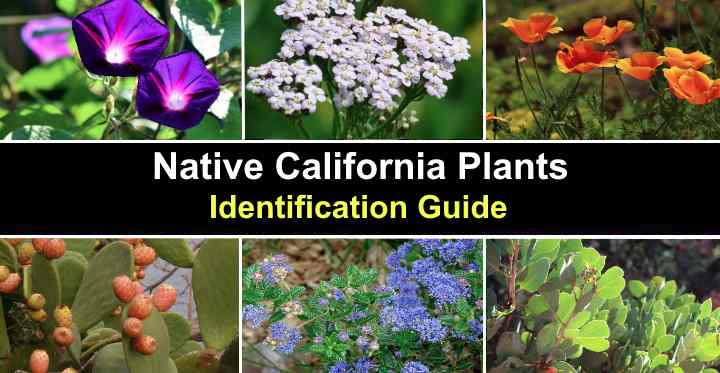
Native California plants are a great choice to plant in landscapes on the Pacific Coast. Plants native to California have adapted to the local climate and soil conditions and play a crucial role in local ecosystems. Also, planting native California plants in your front or backyard provides important habitat and food sources for local wildlife, including birds, butterflies, and bees.
What is a Native Garden?
A native garden replicates the local ecosystem by using plants that naturally grow in a specific region. In California, this means planting species adapted to the state’s distinct climate, soil, and wildlife.
Why Plant Native Plants in a California Garden?
Native California plants require minimal water, fertilizers, and pesticides due to their adaptability to local conditions. Native gardens are a low-maintenance, aesthetically pleasing choice, blending harmoniously with California’s natural landscapes. Above all, embracing native species is a responsible way to contribute to the preservation of the state’s distinctive ecosystems.
This article is a guide to flowers, shrubs, trees, and other plants native to California. Descriptions and pictures of native plants will help you choose the best species to incorporate into your garden landscape.
Native California Flowers
Flowers native to California can add color, fragrance, and texture to landscapes on the western coast of the US. Here are some of the top native California flowers to grow in your front or backyard.
California Fuchsia (Epilobium canum)
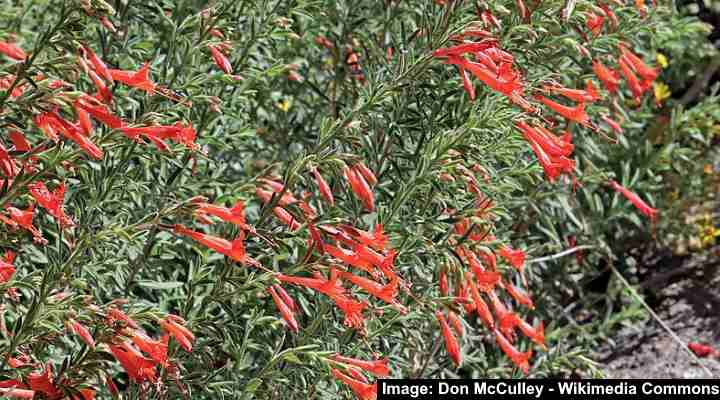
California fuchsia is an eye-catching flowering plant with bright red tubular flowers blooming in late summer and fall. The sun-loving plant is identified by its slender trumpet-like flowers growing on tall stems, narrow, lanceolate grayish-green leaves, and long seed pods. The late-blooming plant grows up to 2 ft. (0.6 m) tall.
The spectacular orange-red flowers of California fuchsia add a splash of color to Western landscapes. The native California flowers perform well in rock gardens, growing as red-flowering ground cover or brightening the front of a border.
- USDA Growing Zone: 8 to 11
- Sun Exposure: Full sun
- Mature Size: 1 to 2 ft. (0.3 – 0.6 m) tall and 2 to 3 ft. (0.6 to 0.9 m) wide
- Soil Needs: Well-drained, sandy, or gritty soil
- Water Needs: Low water requirements and drought-tolerant once established
California Milkweed (Asclepias californica)

California milkweed blooms with small pinkish-purple star-shaped flowers in the lower northern, southern, and central regions of the Golden State. The flowering perennial is easily identifiable by its thick, white, woolly stems, hanging purple, pink, or lavender flowers, and milky sap. The drought-tolerant plant is a host for monarch butterflies.
California milkweed thrives in full sun, where it is a great addition to butterfly gardens. This native plant thrives in California’s ecosystems as a natural landscaping plant for planting along borders or adding color and texture to flower beds. It is also deer-resistant and is ideal for wildlife habitats or naturalized areas.
- USDA Growing Zone: 3 to 9
- Sun Exposure: Full sun or partial shade
- Mature Size: Up to 3 ft. (1 m) tall and wide
- Soil Needs: Tolerates sandy and clay soil with excellent drainage
- Water Needs: Drought-tolerant once established, water twice a month in the summer
California Poppy (Eschscholzia californica)

California poppy is a stunning wildflower with orange cup-shaped blooms on upright stems blooming from spring through early winter. Native to the Pacific Coast, the easy-grow orange or yellow four-petalled flowers contrast with blue-green lacy foliage. The delightful flowers are 6” to 8” (15 – 20 cm) wide.
California poppies are the state flower of California. The orange flowers grow in loose, freely branching mounds. The heat and drought-tolerant flowers close when it rains or is dark. Landscaping uses for California poppies include planting in wildflower gardens, borders, rock gardens, or along pathways to add vibrant color to landscapes.
- USDA Growing Zone: 8 to 10
- Sun Exposure: Full sun
- Mature Size: 0.5 to 1 ft. (0.15 – 0.3 m) tall and wide
- Soil Needs: Well-drained sandy, poor to average soils
- Water Needs: Low to moderate water needs
Blue-Eyed Grass (Sisyrinchium bellum)

Blue-eyed grass is known throughout the Golden State for its spectacular purple-violet trumpet-shaped flowers with yellow centers. The iris-like flowers bloom in late winter to early summer and grow in erect clumps surrounded by sword-shaped bluish-green leaves. The sun-loving purple flowers don’t grow taller than two feet (0.6 m).
Despite its name, blue-eyed grass is not a type of ornamental grass. Instead, it’s a purple-flowering semi-evergreen perennial native to California. The flowers measure 0.4” to 0.8” (1 – 2 cm) across. With their spreading growth, the attractive purple flowers are ideal for ground cover, pollinator gardens, or colorful borders.
- USDA Growing Zone: 7 and 8
- Sun Exposure: Full sun or partial shade
- Mature Size: Up to 2 ft. (0.6 m) tall and wide
- Soil Needs: Well-draining soil
- Water Needs: Regular watering to keep the soil moist in spring but avoid overwatering in summer
Western Yarrow (Achillea millefolium)
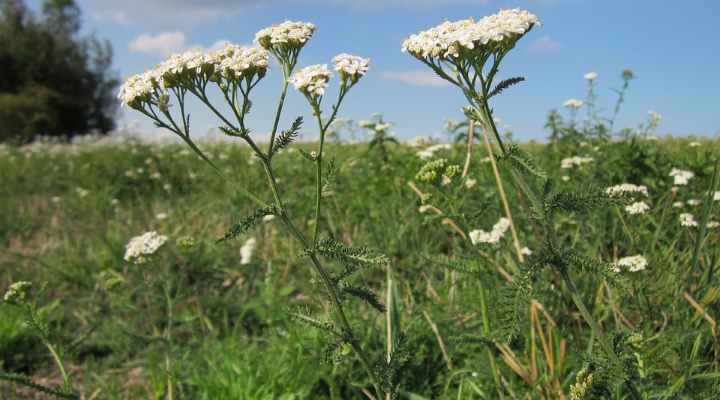
Western yarrow is a perennial wildflower with huge flat-topped clusters of white flowers that bloom in summer. Thriving in the sun, the flowerheads measure 5” (13 cm) across, comprising up to 25 cream-white blossoms. The flowers sit on tall stems surrounded by fragrant fern-like foliage.
Western yarrow is a hardy plant that grows in upright clumps up to 3 ft. (1 m) tall. The best flowering occurs in full sun, where the flowers beautify wildflower gardens, mixed borders, and coastal gardens. It’s ideal for California’s climate as it tolerates heat, humidity, drought, and heat.
- USDA Growing Zone: 3 to 9
- Sun Exposure: Full sun or partial shade
- Mature Size: 2 to 3 ft. (0.6 – 1 m) tall and 2 ft. (0.6 m) wide
- Soil Needs: Tolerant of poor to medium fertile soils
- Water Needs: Drought tolerant once established and can survive in arid conditions
Douglas Iris (Iris douglasiana)

Native to the coastal regions of North and Central California, Douglas iris is an attractive purple-flowering plant that blooms in spring. The shade-tolerant evergreen clumping perennial has bluish-purple flowers and sword-shaped arching leaves. The iris is ideal for planting in shaded areas of your garden to add color and texture.
Douglas iris plants are low-growing spreading plants growing up to 2 ft. (0.6 m) tall. The flowers are well-suited for growing in rock gardens, borders, or naturalized areas. It prefers well-drained soil and can tolerate full sun to partial shade.
- USDA Growing Zone: 7 to 9
- Sun Exposure: Full sun or partial shade
- Soil Needs: Well-drained soil when growing along the coast
- Water Needs: Water regularly in the summer if growing inland
- Mature Size: 1 to 2 ft. (0.3 to 0.6 m) tall and 2 to 4 ft. (0.6 – 1.2 m) wide
Island Alum Root (Heuchera maxima)

Island alum root is an attractive white-flowering plant native to California’s Channel Islands. This plant is known for its clusters of white bell-shaped flowers blooming in late winter and spring on the top of erect stems. The perennial herbaceous plant has large, round, deeply lobed leaves with a glossy green color.
Island alum root performs best in coastal garden landscapes in full sun or partial shade. It’s characterized by its low-growing clumps of foliage with tall flowering stalks standing 23” (60 cm) above it. This native California plant is ideal for growing in rock gardens, borders, containers, or as ground cover. If planted inland, island alum root grows best in full shade.
- USDA Growing Zone: 6 to 10
- Sun Exposure: Full sun, partial shade, or full shade
- Mature Size: 1 to 3 ft. (0.3 – 1 m) tall and 2 ft. (0.6 m) wide
- Soil Needs: Well-draining sandy or rocky soil
- Water Needs: Moderate watering, maximum of three times a month in summer
Mountain Violet (Viola purpurea)

Native to the western US, mountain violet is identified by its small, delicate bright yellow flowers and lance-shaped leaves. The beautiful star-shaped flowers have five bright yellow petals with purple streaks or veins and purplish undersides. Also, the thick, fleshy leaves have prominent indented veins.
Also called goosefoot violet or pine violet, mountain violets are ideal bedding plants for California gardens. This low-maintenance plant performs well in rock gardens, container gardens, or colorful borders. Its spreading habit makes it a good full-sun ground cover plant with yellow flowers. The low-growing yellow-flowering plant is deer-resistant and thrives in full sun.
- USDA Growing Zone: 5 to 8
- Sun Exposure: Full sun or partial shade
- Mature Size: 1.5” to 10” (4 – 15 cm) tall
- Soil Needs: Well-drained, dry, poor, or rocky soil
- Water Needs: Drought-tolerant when established
Baby Blue Eyes (Nemophila menziesii)
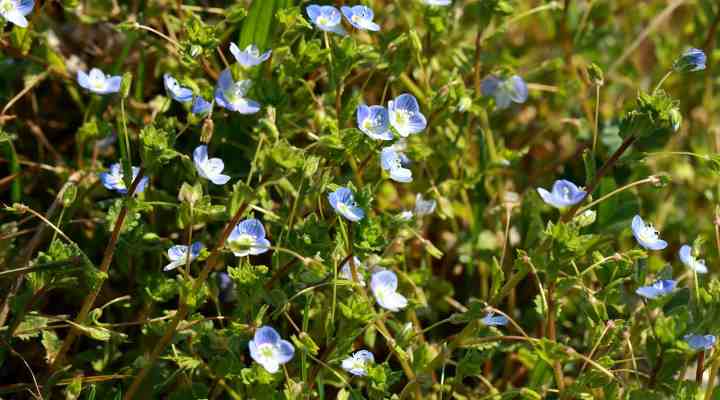
Baby blue eyes is a delicate blue-flowering trailing plant that grows throughout California, blooming from late winter to early summer. The identifying plant characteristics are its cup-shaped bright blue and white flower clusters, small fern-like leaves, and low-growing stature. The delightful wildflowers measure 1.5” (4 cm) across and bloom atop direct stems 6” (15 cm) tall.
Baby blue eyes plants look spectacular, growing massed in sunny landscapes. The popular landscaping annual flowers add a touch of true blue color to beds and borders, rock gardens, or garden edging. You can also plant baby blue eyes as ground cover to enjoy their attractive blue flowers in early spring.
- USDA Growing Zone: 2 to 11
- Sun Exposure: Full sun or partial shade
- Soil Needs: Well-drained, fertile soils
- Water Needs: Keep the ground consistently moist in summer
- Mature Size: 3” to 6” (7.5 – 15 cm) tall and up to 12” (30 cm)
Wind Poppy (Papaver heterophyllum)

Wind poppy is a beautiful orange four-petalled flower endemic to California and blooms from February to late May. This short-lived annual is identified by its four papery orange petals surrounding a deep red or greenish-yellow disk. The vibrant orange flowers bloom on wiry stems with lobed leaves.
Wind poppy flowers are plants that add a touch of beauty to California gardens. They are easy to grow and tolerant of the diverse climate along the Pacific Coast. The orange flowers add a rich splash of orange color to sunny, dry landscapes.
You can plant the orange poppies in rock gardens, butterfly gardens, or cottage gardens. They also add color and texture to borders and xeriscape landscapes.
- USDA Growing Zone: 6 to 11
- Sun Exposure: Full sun or partial shade
- Mature Size: Up to 2 ft. (0.6 m) tall and 1 ft. (0.3 m) wide
- Soil Needs: Well-drained soil
- Water Needs: Moderate water requirements
Blazing Star (Mentzelia lindleyi)

Blazing star is a native California wildflower with bright yellow flowers that bloom in spring and summer. The sun-loving flowers are star-shaped with five large, pointed petals and a cluster of showy stamens in the center. Its long, thin petals give them a unique, star-like appearance. The plant also has fuzzy dandelion-like leaves.
Blazing star is a hardy yellow-flowering plant that tolerates heat, poor soil, wind, and drought. It thrives in California’s coastal regions as an ornamental plant for adding bright, sunny colors to front or backyards. This native wildflower is great for flower beds, desert rock gardens, and poor, sandy soils. A single plant may have 25 yellow blooms.
- USDA Growing Zone: 7 to 9
- Sun Exposure: Full sun
- Mature Size: 1 to 3 ft. (0.3 – 1 m) tall
- Soil Needs: Rocky, well-drained soil
- Water Needs: Minimal watering is required
Morning Glory (Calystegia)

Morning glory is a fast-growing annual vine that produces beautiful trumpet-shaped flowers from mid-spring through fall. Endemic to California, morning glory flowers can bloom in blue, purple, pink, white, and bi-color shades. As the name suggests, the creeping plant’s flowers bloom in the morning and close in the afternoon.
Morning glory flowers are popular for adding color and vertical interest to trellises, fences, or garden structures. Due to its trailing vines, the flowering plant is ideal for planting in hanging baskets or growing as ground cover in coastal regions. The low-maintenance vines tolerate salt spray, drought, and wind.
- USDA Growing Zone: 9 to 11
- Sun Exposure: Full sun
- Mature Size: Up to 10 ft. (3 m) tall and spreads out to cover a large area
- Soil Needs: Sandy. well-drained soils
- Water Needs: Regular watering to keep the soil moist
Western White Clematis (Clematis ligusticifolia)

Western white clematis is a spreading, climbing vine with showy, white, star-shaped flowers that bloom in the spring and early summer. The native plant’s fragrant flowers measure 2” (5 cm) across and are characterized by narrow, elongated creamy-white petals. These contrast nicely with rich, dark green lanceolate leaves. It’s known for its fluffy, white seed heads that resemble a beard, hence its common name.
Also called Western virgin’s bower or old-man’s beard, the climbing white-flowering vine adds bright color and vertical interest to garden landscapes. You can plant this climbing clematis to scramble over fences, trellises, or walls. The rich, luscious foliage and white flowers add a touch of elegance to California garden landscapes.
- USDA Growing Zone: 4 to 8
- Sun Exposure: Full sun or partial shade
- Mature Size: Up to 30 ft. (9 m) tall and 6 ft. (1.8 m) wide
- Soil Needs: Well-draining soil
- Water Needs: Regular watering during summer to keep the soil moist
Redwood Sorrel (Oxalis oregana)

Redwood sorrel, or Oregon oxalis, is a white-flowering ground cover plant with white or pale pink flowers that blooms from spring through fall. The native California plant thrives in the shade, producing attractive whitish flowers with lavender veining and a yellow-greenish throat. Native to the Pacific Northwest, the plant’s slender stems have velvety shamrock-like leaves.
Redwood sorrel’s deep green foliage and pinkish-white flowers are ideal for ground cover in shady gardens. Additionally, its trailing stems make it a great addition to patios or decking areas cascading from containers or hanging baskets. Due to its rhizomatous roots, the plant will spread indefinitely.
- USDA Growing Zone: 7 to 9
- Sun Exposure: Partial shade to full shade
- Mature Size: 4” to 10” (10 – 25 cm) tall and up to 30 ft. (9 m) wide
- Soil Needs: Well-drained soil
- Water Needs: Moderate to high water needs
Hummingbird Sage (Salvia spathacea)

Salvia spathacea, commonly known as the hummingbird sage or pitcher sage, is a beautiful and ecologically significant native Californian plant. It is a perennial herbaceous plant that typically reaches a height of one to three feet (0.3 – 0.9 m). The leaves are deep green, lance-shaped, and emit a pleasant, earthy aroma when crushed.
Its distinctive, tubular flowers range in color from light pink to deep magenta and attract hummingbirds and butterflies, making it a popular choice for wildlife gardens.
This sage species is well adapted to California’s Mediterranean climate, which includes hot, dry summers and mild, wet winters. Its ability to withstand periods of drought makes it a resilient choice for landscaping in California’s arid regions.
Salvia spathacea is a favorite among native plant enthusiasts and gardeners seeking to create sustainable, drought-tolerant landscapes. It requires minimal maintenance and can be an attractive addition to home gardens, providing a touch of native beauty.
- USDA Growing Zone: 8 to 10, though it can also be found in some zone 7 locations within its natural range
- Sun Exposure: Partial to full sun, but can tolerate some shade
- Soil Needs: Prefers well-draining soils. Sandy or loamy soils with good drainage are ideal. It can tolerate a variety of soil types, from acidic to slightly alkaline.
- Mature Size: 1 – 3 feet (0.3 – 0.9 m) height and width. It maintains a neat and bushy appearance.
- Water Needs: While Salvia spathacea is drought-tolerant, it benefits from occasional deep watering, especially during prolonged dry periods. However, it should not be overwatered, as it is adapted to the Mediterranean climate of California, where it experiences a dry summer season. Once established, it can thrive with minimal irrigation
Native California Shrubs
Shrubs native to California and the Pacific Coast add texture, color, and beauty to Western landscapes. Here are some of the best bushy plants to grow in your front or backyard.
California Buckwheat (Eriogonum fasciculatum)

California Buckwheat is a common native shrub that grows in southern California. It is renowned for its clusters of delicate and decorative flowers, which add a touch of elegance to the California landscape. The flowers dry to reddish color when the soil dries,
The flowers of California Buckwheat are composed of small and intricate tiny clusters of white and pink, papery blossoms. Each tiny flower consists of five to six petals radiating from a central, golden-yellow disk.
California Buckwheat typically blooms from late spring through summer. The exact timing of the bloom may vary depending on local climate conditions and specific microclimates within California. The plant’s flowering period can extend from late May through July or even into early August.
The transition of the flowers from white to rusty red as they dry ensures that the plant remains visually appealing throughout its bloom season, providing year-round interest in native plant gardens.
California buckwheat is well adapted to the region’s Mediterranean climate and is known for its drought tolerance, making it a popular choice for xeriscape gardens and water-wise landscaping.
- USDA Growing Zone: 7a-11b
- Sun Exposure: Full sun
- Soil Needs: Dry or mostly dry well-draining soils
- Mature Size: 1 to 6 feet tall (0.3 – 1.8 m)
- Water needs: drought tolerant
California Tree Poppy (Romneya coulteri)

California tree poppy, also known as Coulter’s Matilija poppy, is a spectacular white-flowering shrub-like perennial native to dry chaparral and coastal sage scrub plant communities in Southern California. It is known to thrive in the nutrient-poor, often sandy soils of the region and can sometimes grow in recently burned areas.
Blooming from late spring through summer, this large shrubby plant produces pure white flowers with five or six papery petals surrounding a golden-yellow center. These white blossoms emerge on thick stems, creating a beautiful contrast with the deeply lobed green leaves.
California tree poppy is a fast-growing plant growing up to 8 ft. (2.4 m) tall. It thrives in full sun with its apricot-scented white flowers. These blossoms add elegance and charm to borders, foundation plantings, and cottage gardens. It’s also drought-tolerant and deer-resistant, making it ideal for low-maintenance gardens.
- USDA Growing Zone: 8 to 10
- Sun Exposure: Full sun or dappled sunlight
- Mature Size: 6 to 8 ft. (1.8 – 2.4 m) tall and wide
- Soil Needs: Well-draining soil
- Water Needs: Moderate to low water requirements once established
California Sagebrush (Artemisia californica)

California sagebrush is a native shrub well-adapted to California’s dry conditions. This plant is identified by its small cup-shaped yellow flowers, silvery-gray aromatic foliage, and white, fuzzy seed pods. The ornamental shrubby plant forms a rounded crown with slender, flexible stems. Despite its name, it doesn’t belong to the sage family Salvia.
California sagebrush is an extremely drought-tolerant shrub and thrives in poor, sandy soils. Ideal for xeriscaping, the shrubby bush is ideal for native plant gardens, coastal landscapes, or containers. It prefers full sun exposure and can withstand hot, dry conditions. You can also use sagebrush as a border plant or a natural screen.
- USDA Growing Zone: 7 to 9
- Sun Exposure: Full sun
- Mature Size: 5 to 8 ft. (1.5 – 2.4 m) tall and 4 ft. (1.2 m) wide
- Soil Needs: Fast-growing in well-draining, sandy soils
- Water Needs: Very low water requirements
Bush Anemone (Carpenteria californica)
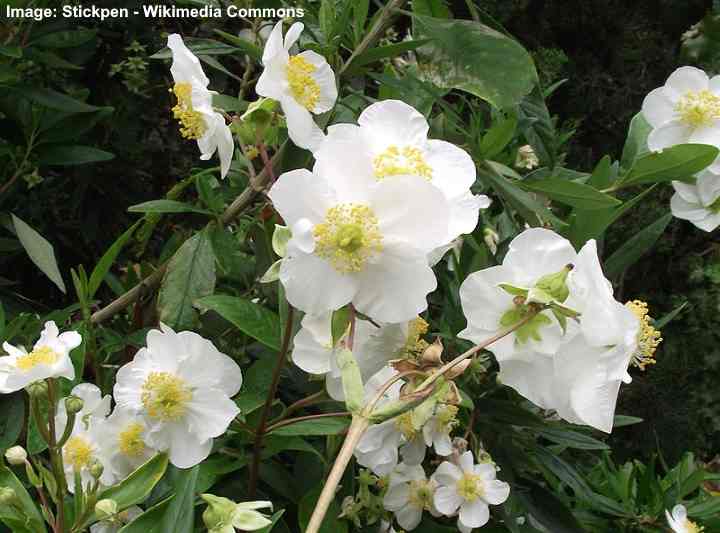
Bush anemone is one of the most beautiful shrubs with white flowers native to California. The white-flowering shrub blooms from spring to fall with large, fragrant, five-petalled, white flowers. The showy, brilliant white anemone-like blooms contrast with glossy, dark green narrow leaves. The white flowers measure 3” (7.5 cm) across.
Easy-care bush anemone shrubs are low-maintenance ornamental plants. The bright flowers and shiny foliage add beauty to wall-side borders, foundation plantings, and butterfly gardens. Also, its dense evergreen foliage makes it ideal for a year-long privacy screen in sunny landscapes. Its tolerance for shade makes it a highly versatile shrubby plant.
- USDA Growing Zone: 8 to 10
- Sun Exposure: Full sun, dappled sunlight, or partial shade
- Mature Size: 4 to 8 ft. (1.2 to 2.4 m) tall and wide
- Soil Needs: Well-draining soil
- Water Needs: Low water requirements once established
Orange Bush Monkey Flower (Mimulus aurantiacus)

Orange bush monkey flower is an exotic native shrub with clusters of vibrant trumpet-like orange flowers blooming in late spring and summer. Native to Oregon and California, the tubular flowers can be orange, yellow, or orange-red and 1.2” (3 cm) long. The shrub has dark-green, narrow, lanceolate leaves 3” (7.5 cm) long.
The colorful shrub, with its brightly colored fragrant flowers, attracts hummingbirds, bees, and butterflies to the gardens along the Pacific Coast. The orange-flowering shrub is drought-tolerant and is ideal for brightening foundation lines, rock gardens, and shrub borders. It’s also ideal for native or Mediterranean-inspired landscapes.
- USDA Growing Zone: 7 to 11
- Sun Exposure: Full sun or partial shade
- Mature Size: 3 to 4 ft. (1 – 1.2 m) tall and 3 ft. (1 m) wide
- Soil Needs: Well-drained, dry, rocky, or sandy soil
- Water Needs: Drought-tolerant, low water requirements
California Bush Sunflower (Encelia californica)

California bush sunflower is a stunning yellow-flowering shrub blooming in spring and summer. Thriving in full sun, the native shrub has bright yellow ray flowers resembling small sunflowers 3” (7.5 cm) in diameter. Its multiple branches are brittle and have bright green oval leaves that drop in drought seasons.
Ideal for wildlife gardens, California bush sunflower grows up to 3 ft. (1 m) tall. Its drought, salt spray, and heat tolerance make it suitable for planting in dry, arid climates. You can use the bushy sunflower plant in xeriscaping, perennial beds, and water-wise borders.
- USDA Growing Zone: 10 and 11
- Sun Exposure: Full sun
- Mature Size: 2 to 3 ft. (0.6 – 1 m) tall and 3 to 4 ft. (1 – 1.2 m) wide
- Soil Needs: Well-draining sandy soil, and it can tolerate poor soil conditions
- Water Needs: Drought-tolerant, requires little water once established
California Gooseberry (Ribes californicum)

California gooseberry is native to the Golden State. It is known for its unique, attractive red and white, fuchsia-like dangling flowers. Blooming in late winter and early spring, the bell-shaped flowers grow in clusters of one to three. The shrub produces three-lobed glossy green leaves and red, fuzzy edible berries.
The California gooseberry shrub has spiny thorns along its branches. This makes the large deciduous shrub a good choice for foundation planting or security screens. Additionally, its usefulness in wildlife and pollinator gardens means it attracts hummingbirds, butterflies, and other pollinators. It’s best to avoid planting the thorny bush next to walkways.
- USDA Growing Zone: 7 to 10
- Sun Exposure: Partial shade
- Mature Size: 3 to 8 ft. (1 – 2.4 m) tall and up to 6 ft. (1.8 m) wide
- Soil Needs: Well-draining rocky or sandy soils
- Water Needs: Moderate water requirements for the best blooming and fruit production
California Lilac (Ceanothus)

California lilac is a group of blue-flowering shrubs with attractive rounded to conical clusters of tiny blue flowers. Blooming in spring or summer, the shrubs are identified by their fragrant flower clusters, glossy foliage consisting of spiny, holly-like leaves, and vigorous growth. California lilacs can be low-growing ground cover plants to tall ornamental shrubs, depending on the variety.
California lilac shrubs are versatile plants with many uses in west-coast landscapes. Their salty spray and wind tolerance make them ideal for beachfront or coastal gardens. Larger lilac shrubs enhance curb appeal in front yards. Smaller California lilac shrubs are perfect for container planting to add a splash of blue or purple colors to a balcony or patio.
- USDA Growing Zone: 7 to 10
- Sun Exposure: Full sun or partial shade
- Mature Size: 2 to 20 ft. (0.6 to 6 m) tall and 4 to 25 ft. and (1.2 – 7 m) wide, depending on the variety
- Soil Needs: Well-drained dry, rocky, or sandy soils
- Water Needs: Drought-tolerant but will benefit from occasional watering
Coffeeberry (Frangula californica)

Coffeeberry, native to the Southwestern US, is an evergreen shrub with clusters of spring-blooming greenish flowers. The outstanding feature of coffeeberry is its dark red to black berries containing two seeds resembling coffee beans. The plant has dark green, glossy, leathery leaves with lighter undersides.
Coffeeberry is a popular shrub for landscaping in California due to its drought tolerance and ability to attract wildlife. You can plant coffeeberry shrubs in water-efficient xeriscapes. Its evergreen foliage acts as an effective hedge, privacy screen, or specimen plant. Its ornamental berries provide visual interest in early fall.
- USDA Growing Zone: 7 to 10
- Sun Exposure: Full sun to partial shade
- Mature Size: 3 to 12 ft. (1 – 3.6 m) tall
- Soil Needs: Most types of well-draining soil
- Water Needs: Moderate to low water requirements
California Flannelbush (Fremontodendron californicum)

California flannelbush is an evergreen yellow-flowering shrub native to California. The vigorous, ornamental shrub blooms in late spring through summer. Its blossoms are masses of large, bright yellow, saucer-shaped flowers. The other shrub identification feature is its rounded, leathery lobed leaves that measure 4” (10 cm) long. The leaves are covered in irritating hairs.
California flannelbush is a fast-growing broadleaf shrub that grows on dry hillsides in the Golden State. Landscaping uses for the yellow shrub include foundation planting, an evergreen hedge, and borders. However, it’s best to avoid planting near walkways or patios because of its irritating nature.
- USDA Growing Zone: 8 to 10
- Sun Exposure: Full sun
- Mature Size: 8 to 18 ft. (2.4 – 5 m) tall and 6 to 10 ft. (1.8 – 3 m) wide
- Soil Needs: Well-draining, poor-to-average soil
- Water Needs: Drought-tolerant but will benefit from occasional watering during dry periods
Common Manzanita (Arctostaphylos manzanita)
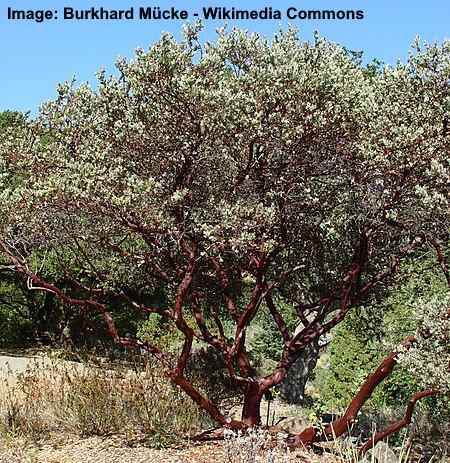
Common manzanita is an evergreen shrub with whitish-pink flowers that bloom in late winter to early spring. It has wedge-shaped leaves and distinctive mahogany-colored bark. Native to the western United States and commonly found in the California chaparral, the ornamental shrub is notable for its twisted branches and spreading crown. With its winter blossoms, small ornamental fruits, and evergreen foliage, common manzanita provides year-round visual interest.
Common manzanita grows up to 12 ft. (3.6 m) tall in the North Coast Range and northern and central areas of the Sierra Nevada foothills. Its drought tolerance makes the large shrub ideal for xeriscape gardens, Mediterranean or desert-themed landscapes, or a specimen plant.
- USDA Growing Zone: 8 to 10.
- Sun Exposure: Full sun or partial shade
- Mature Size: 10 to 12 ft. (3 – 3.6 m) tall and wide
- Soil Needs: Various well-drained soil types
- Water Needs: Low to moderate water requirements
California Christmas Berry (Heteromeles arbutifolia)
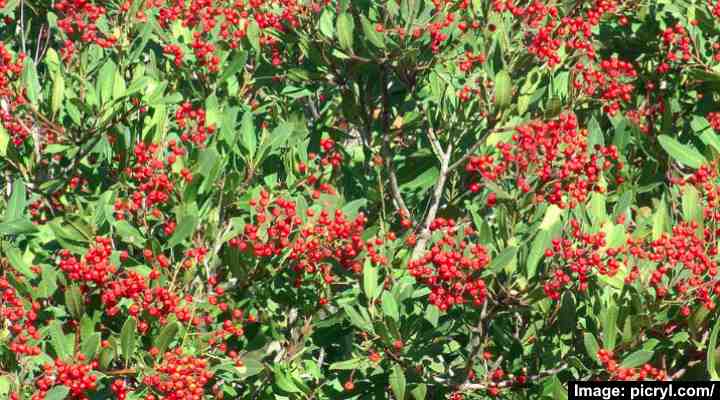
Also called Toyon, the California Christmas berry is prized for its small white flowers, bright red berries, and leathery dark green leaves. Native to California, the white-flowering shrub blooms profusely in summer with flat-topped clusters. The flowers give way to pea-sized shiny red berries, contrasting with lanceolate leaves.
The California Christmas berry shrub thrives in both sunny and partially shaded landscapes and is commonly found in chaparral communities throughout much of California. This beautiful, low-maintenance shrub excels as an accent plant, an evergreen hedge, a screen, or a butterfly bush in wildlife gardens. With its year-round green foliage, white summer flowers, and red fall berries, it makes a great addition to garden landscapes.
- USDA Growing Zone: 9 to 11
- Sun Exposure: Full sun or partial shade
- Mature Size: 6 to 8 ft. (1.8 – 2.4 m) tall and up to 5 ft. (1.5 m) wide
- Soil Needs: Tolerant of a variety of soil conditions, including clay and sand
- Water Needs: Moderate water requirements
Native California Trees
Native California trees are vital additions to western landscapes for shade, privacy, and ornamental features. Trees native to the Golden State range from the decorative western redbud to huge cypress and sequoia trees.
Western Redbud (Cercis occidentalis)
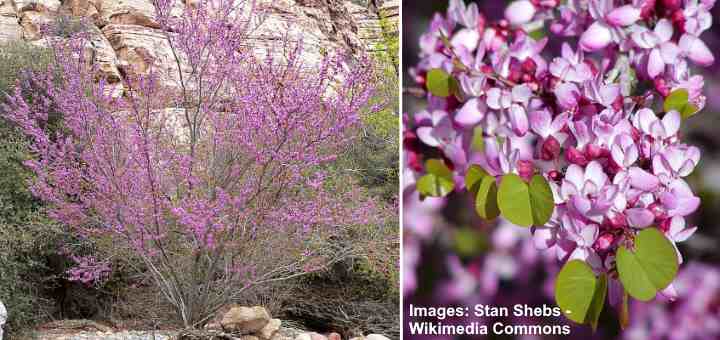
Western redbud is a stunning ornamental tree with masses of pink to purple flowers blooming in early spring. Thriving in full sun, the spring pea-shaped blossoms add a splash of color before the heart-shaped leaves appear. Additionally, the twisted branches and vase-shaped crown give the tree an attractive silhouette in winter.
The western redbud grows easily in full sun in landscapes along the Pacific Coast. You can grow the native tree as a specimen plant or use it to add a splash of spring color to shrub borders. Its compact growth habit makes it ideal for small gardens in California.
- USDA Growing Zone: 6 to 9
- Sun Exposure: Full sun to partial shade
- Soil Needs: Well-drained soil
- Water Needs: Moderate water needs, but can tolerate some drought once established
- Mature Size: 10 to 15 ft. (3 – 4.5 m) tall and wide
Native California Pine Trees (Pinus)
Native California pine trees are a common sight along the Pacific Coast. The evergreen coniferous trees are identified by their tall and majestic appearance, bright green, or bluish-green needle-like leaves, and reddish-brown bark. An identifying feature of pines is their needles that grow in bundles of two or three.
Here are ways to identify some of the most common pine trees in California:
Ponderosa Pine (Pinus ponderosa): This is the most common native pine tree in California. It’s identified by its straight trunk, long needles in bundles of three, and large, elongated pine cones. It has reddish-brown, deeply furrowed, exfoliating bark. The tall pine is found in the Sierra Nevada and Cascade ranges.

Ponderosa pine (Pinus ponderosa)
Coulter Pine (Pinus coulteri): Found in Southern California, the coulter pine has large spiky pine cones—the largest of any pine tree. Also, it has long needles in bundles of three and grayish-brown, scaly bark. It grows up to 80 ft. (24 m) tall.
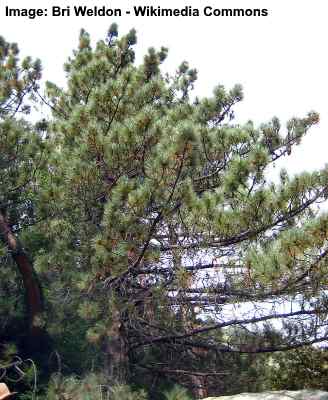
Coulter pine (Pinus coulteri)
Sugar Pine (Pinus lambertiana): The largest species of native pine tree in California. The sugar pine is identified by its long, slender pine cones, flexible needles in bundles of five, and deeply furrowed, grayish-brown bark.

sugar pine (Pinus lambertiana)
Native California Cypress Trees (Cupressus)
Native California cypress trees are common coniferous trees along the Pacific Coast and the mountains. Many varieties of tall evergreen cypress trees are native to California. They are known for their scale-like feathery sprays, fibrous bark, and small woody pine cones.
Here are ways to identify three common cypress trees in California:
Monterey Cypress (Cupressus macrocarpa): This native cypress is common throughout the Golden State. It’s known for its distinctive, dark green foliage of flat sprays, crooked or leaning trunk, and reddish-brown bark. Monterey cypress is commonly found along the California coast, growing up to 133 ft. (40 m).
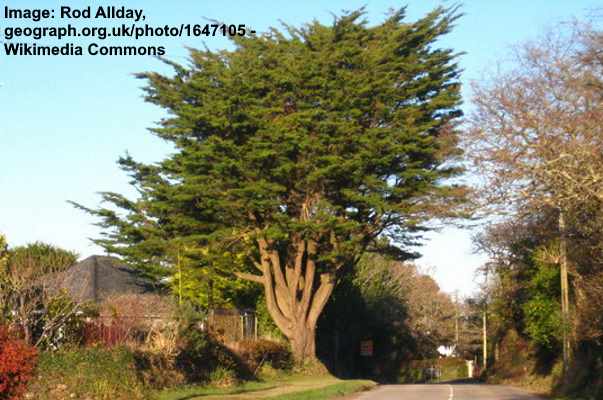
Monterey cypress (Cupressus macrocarpa)
Santa Cruz Cypress (Cupressus abramsiana): Native to California, this cypress is identified by its light green, scale-like feathery leaves, conical shape, and fibrous gray bark that peels in strips. Typically found in the Santa Cruz Mountains, the cypress grows up to 82 ft. (25 m) tall.

Santa Cruz cypress (Cupressus abramsiana)
Arizona Cypress (Cupressus arizonica): This striking evergreen native conifer has a narrowly conical shape, fine, scale-like aromatic bluish-green leaves, and small, round cones. It thrives in arid climates, growing up to 82 ft. (25 m) in height.
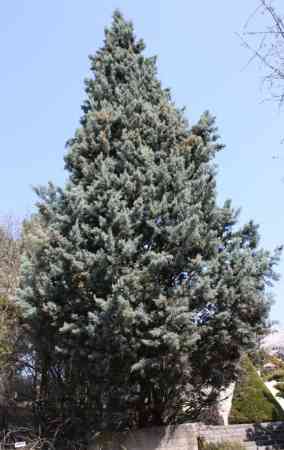
Arizona cypress (Cupressus arizonica)
California Bay Laurel (Umbellularia californica)

California bay laurel is a large hardwood tree with thin, smooth bark, lance-shaped aromatic leaves, and small yellow flowers that bloom in the spring. Native to California’s coastal forests, the evergreen tree grows to 80 ft. (24 m) tall. It also produces small, round, green berries called the California bay nut.
- USDA Growing Zone: 7 to 9
- Sun Exposure: Full sun, partial shade, full shade
- Mature Size: 20 to 80 ft. (6 – 24 m) tall and up to 100 ft. (30 m) wide
- Soil Needs: Deep, well-drained soils
- Water Needs: Grow best with moderate moisture but can withstand drought
Pacific Madrone (Arbutus menziesii)

Pacific madrone, native to California, is a stunning evergreen flowering tree. Its identifying features are its smooth red bark, glossy dark green leaves, and clusters of white or pink bell-shaped flowers. Blooming in spring in full sun, the Pacific madrone tree has tremendous ornamental value. In addition to its urn-like flowers, it produces brilliant red-orange berries.
Pacific madrone is described as California’s most beautiful broadleaf flowering evergreen tree.
- USDA Growing Zone: 7 to 9
- Sun Exposure: Full sun to partial shade
- Mature Size: 20 to 50 ft. (6 – 15 m) tall and wide
- Soil Needs: Acidic well-drained soils
- Water Needs: Average moisture with good drainage
California Black Oak (Quercus kelloggii)
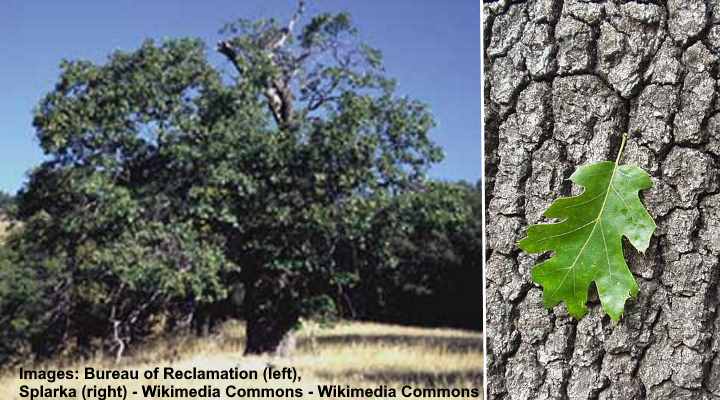
California black oak is a native red oak tree species identified by its thick, plate-like bark, deeply lobed leaves, and large acorns 1.5” (4 cm) long. Native to the lower foothills of California, the deciduous tree has a rounded crown and grows to 80 feet (24 m) tall.
The large black oak is well-suited for planting in larger landscapes, parks, or open areas to provide shade.
- USDA Growing Zone: 6 to 10
- Sun Exposure: Full sun to partial shade
- Mature Size: Typically 30 to 50 ft. (9 – 15 m) tall and up to 30 ft. (9 m) wide
- Soil Needs: Moist to dry, well-drained soils
- Water Needs: Moderate to low water requirements once established
California Redwood (Sequoia sempervirens)

The California redwood is a magnificent and iconic tree native to the coastal regions of California. These towering trees have scale-like leaves, egg-shaped seed cones, and impressive height, with some growing 380 ft. (116 m) tall. The native redwoods have a straight trunk, conical crown, and thick, reddish-brown fibrous bark.
- USDA Growing Zone: 7 to 9
- Sun Exposure: Full sun to partial shade
- Mature Size: Up to 380 ft. (116 m) tall and 26 ft. (8 m) wide at breast height
- Soil Needs: Moist, well-drained soils
- Water Needs: Moderate to high water needs, requiring up to 800 gallons of water daily in summer
Other Native California Plants
California is also home to other types of native plants—cacti, ornamental grasses, and succulents.
Coastal Prickly Pear (Opuntia littoralis)

Coastal prickly pear is a type of cactus native to areas of California along the Pacific Coast. The green cactus is identified by its large oval, spiky paddle-shaped pads growing in dense clumps. The native desert cactus blooms in spring with yellow flowers, followed by egg-shaped bright red fruit.
Coastal Prickly Pear is a unique and striking succulent that can make a beautiful addition to your garden. When planting Coastal Prickly Pear, it’s essential to consider its sharp spines and take precautions to prevent accidental contact.
- USDA Growing Zone: 9 to 11
- Sun Exposure: Full sun
- Mature Size: Up to 3 ft. (1 m) tall wide
- Soil Needs: Well-draining sandy or rocky soils
- Water Needs: Drought-tolerant once established
Canyon Live-Forever (Dudleya cymosa)

Canyon live-forever is a heat-loving succulent plant native to California. The succulent is identified by its thick, fleshy gray-green leaves growing in a pretty rosette pattern 6” in diameter. The thick, pointed leaves have pinkish margins in full sun. The succulent plant blooms in mid-spring and summer. It blooms with erect, vibrant red-orange flower spikes and small flowers.
Many other varieties of live-forever succulents are native to California. The desert plants are ideal for xeriscaping, growing in rock gardens, garden edging, or container planting.
- USDA Growing Zone: 6 to 10
- Sun Exposure: Full sun to partial shade
- Soil Needs: Well-draining soil
- Water Needs: Low water needs, drought-tolerant
- Mature Size: 6” (15 cm) tall and wide
Giant Wildrye (Leymus condensatus)

Giant wildrye is a tall, ornamental, clump-forming grass native to coastal areas of California. This grass is identified by its narrow, sword-shaped evergreen leaves, dense spikes of small, light green summer-blooming flowers, and spreading habit. This tough, drought-tolerant plant is perfect for landscaping desert gardens, coastal water-wise gardens, and natural areas.
- USDA Growing Zone: 7 to 10
- Sun Exposure: Full sun or partial shade
- Mature Size: 2 to 3 ft. (0.6 – 1 m) tall and 4 ft. (1.2 m) wide
- Soil Needs: A range of well-drained soils, including clay, sandy, rocky, and saline ground
- Water Needs: Drought-tolerant, requires little water once established
Deergrass (Muhlenbergia rigens)
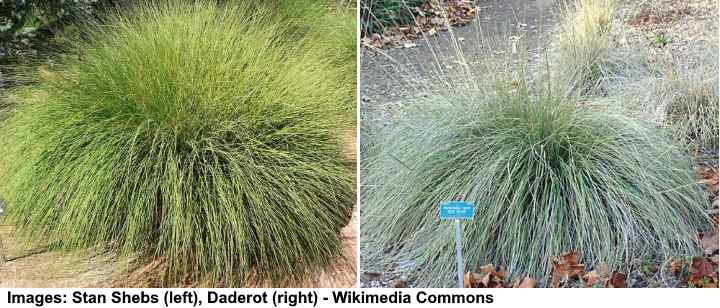
Deergrass is a clumping warm-season grass commonly found in the southwestern United States. Its identifying features are dense mounds of bright green to silver-green blades 3 ft. (1 m) long, purplish flower spikes 5 ft. (1.5 m) tall, and vigorous growth. The ornamental grass is tolerant of heat and drought, ideal for xeric garden landscapes.
Deergrass has various landscaping applications, including ground cover, border edging, foundation planting, and garden accents.
- USDA Growing Zone: 7 to 10
- Sun Exposure: Full sun or light shade
- Mature Size: 3 to 5 ft. (1 – 1.5 m) tall and wide
- Soil Needs: Most soil types that are well-drained
- Water Needs: Low to moderate water requirements
Native California Plants – Frequently Asked Questions (FAQ)
When is the Best Time to Plant Native California Plants in My Garden?
The optimal time to plant native California plants is during the fall or early winter. Planting during this period allows the plants to develop healthy root systems, which is crucial for their overall success.
When you plant in the fall or early winter, the plants have time to establish themselves before the growing season in spring and summer. This ensures that they are well-prepared to thrive and bloom when the warmer weather arrives. Soil amendments are generally not necessary since native plants are already adapted to your area’s specific conditions.
How Do I Care for Native California Plants, and Do They Require Special Maintenance?
Native California plants are often considered low-maintenance, but they do require some seasonal attention to stay at their best. Once established, many of them can thrive without summer watering, but it’s essential to know the specific requirements of each plant in your garden. Regular grooming and maintenance, such as pruning or deadheading, may be necessary to ensure your native plants look their best.
What are the Key Environmental Benefits of Using Native California Plants in Landscaping?
The environmental benefits of using native California plants in landscaping are significant. Native plants are adapted to the local climate, making them naturally drought-tolerant and reducing the need for excess watering. This leads to water conservation and a lighter environmental footprint.
Native gardens also support local wildlife, providing essential food and habitat for birds, bees, butterflies, and other creatures. By reducing the use of pesticides and fertilizers, native gardens help protect the environment from harmful chemicals. Moreover, native California plants add to the beauty and ecological health of your region, contributing to the conservation of the state’s unique biodiversity.
Can I Incorporate Non-Native Plants Alongside Native California Species in My Garden?
It’s entirely possible to incorporate non-native plants alongside native California species in your garden. The key is to select non-native plants that are well-suited to your local climate and share similar water and maintenance requirements with your native plants.
This balanced approach allows you to enjoy a diverse and visually appealing garden while still benefiting from the advantages of native California species. Keep in mind that non-native plants should not become invasive and threaten native species or the local ecosystem. Careful planning and selection are crucial to maintain a harmonious and ecologically responsible garden.
What is the Blooming Season for Native California Plants?
The blooming season for native California plants can vary depending on the specific species. Many native California plants have adapted to the state’s Mediterranean climate, characterized by wet winters and dry summers. Here’s a general guideline:
Spring Bloomers: Some native California plants, like California poppy (Eschscholzia californica) and ceanothus (Ceanothus spp.), bloom during the spring months, typically from March to June. These plants add vibrant colors to your garden as the days become warmer.
Summer Bloomers: Species such as California Christmas berry (Heteromeles arbutifolia) and yarrow (Achillea millefolium) produce their colorful blossoms during the summer, usually from June to August. These plants are well-suited to the drier conditions of summer.
Fall Bloomers: Certain California natives, like California fuchsia (Epilobium canum) and morning glory (Calystegia), grace your garden with blooms during the fall, from September to November. Their flowers provide late-season nectar for pollinators.
Winter Bloomers: While fewer in number, some native plants, such as canyon snow iris (Iris douglasiana ‘Canyon Snow’), continue to bloom in the milder California winters, often from December to February. These plants can add a touch of color during the cooler months.
How Can I Ensure Year-Round Interest in My California Garden?
To ensure year-round interest in your garden, consider selecting a variety of native plants that bloom in different seasons. By doing so, you can create a garden that changes with the seasons, providing continuous beauty and attracting pollinators throughout the year. Additionally, proper garden design and plant combinations can help you achieve an aesthetically pleasing landscape in every season.
Where Can I Buy California Native Plants?
You can buy California native plants from local nurseries, online retailers, native plant sales, native plant societies, botanical gardens, and landscaping companies. Make sure to choose plants native to your specific region in California for the best results.
Related articles:
